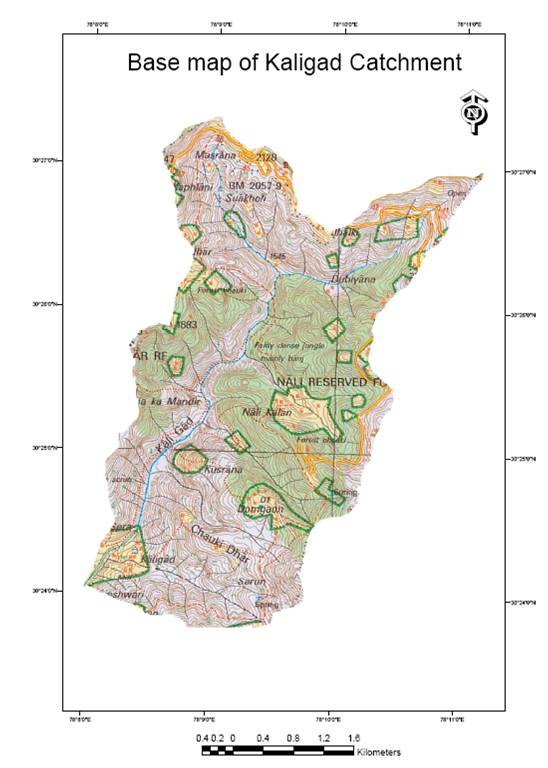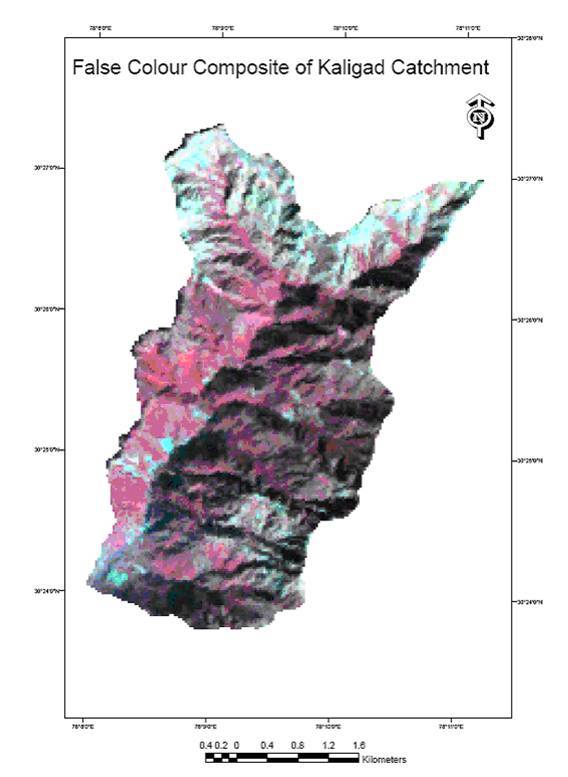Application of remote sensing and GIS in micro-watershed management -Part 2
Return to Part 1, Continue reading Part 3, Part 4
Here we even saw the spot where the people of Soil and Conservation Research Training Institute, Dehradun had constructed “The Mined Area Rehabiltation Research Project, Sahastradhara”
Here even we were able to see engineering restoration structures like gabions, check dams etc.
One more remarkable feature we saw at this place was that a small patch of land which was tilted downwards. It was markedly visible due to the slant nature of the vegetation of that area. The reasons that came into light for the above phenomenon was either the piece of land was moving along a fault line or else at some period of time there might have been a strong wind which has changed the direction of the vegetation.
Spot 4, Sahastradhara: This is the place where we could see the natural springs, the well renowned sulphur spring, many caves and aquifers for which Sahastradhara is famous. Even we saw a very old Shiva temple there.
The Aquifer and recharge zone could be seen. An aquifer is an underground layer of water-bearing permeable rock or unconsolidated materials (gravel, sand, silt, or clay) from which groundwater can be usefully extracted using water well. The place where the aquifer meets the ground surface, the springs are formed. Here, we could also see date palms which were indicators of presence of aquifers.
In the caves here, we could also see stalactites and stalagmites which were formed because of the continuous deposition of Calcium Carbonate and even at places the formed ‘Pillars’.
Spot 5, Abandoned Small Hydro Power Plant: Across the river Baldi, we could see a small construction, where previously laid a Small Hydro Power Plant.
During the restoration work in Sahastradhara, this had been built by building a checkdam further upstream, diverting a part of the river water through a canal along the same contour and then dropping the water suddenly over the height difference. The force of the falling water generated electricity from the turbine. This electricity was used by the nearby villagers, who in turn took the responsibility for the maintenance of the Small Hydro Power Plant.
Sadly enough, there has been no maintenance of this and the whole project currently lay defunct. The room which housed the turbine, currently houses a tea stall.
Methodology
First, the topographical maps were scanned and then geo-referenced in ERDAS Imagine 9.3 to a UTM, WGS 84 projection system, as had been used for the previous geophysical surveys during seismic acquisition. Then a mosaic of the topographical maps was generated. Topographic contours and other geographic information were then digitized from this mosaic of topographical maps. The geological atlas was then scanned and geo-referenced in ERDAS Imagine 9.3, also to the appropriate projection system. Reference points were selected from the same maps.
Ground Control Points (GCPs) were selected from the mosaic of geo-referenced topographical maps and GPS surveys in the field and the GCPs were matched with the GCPs obtained from the topographical map. By combining Bands 4, 3 and 2 of the LISS-III image, a false colour composite (FCC) was generated. Spatial enhancement was also done to the IRS 1-D PAN and LISS-III images. To take advantage of the spatial resolution and spectral resolution of the IRS 1-D PAN and LISS III images, respectively, both the images were “resolution merged” together to obtain a multi-spectral image having higher spatial resolution. Digital Image Processing was carried out in ERDAS Imagine 9.3. A modified geological atlas was generated based on interpretations from the multi-spectral image having higher spatial resolution, following image radiometric enhancements. All the information in the geo-referenced geological atlas ( lithological boundaries as polygon features, faults and axial traces of folds as polyline features and bedding plane dip-strike data as point features) were digitized in Arcinfo 9.3. The road and railway network, settlement, drainage of the region was also updated using the merged satellite image. A land use map was also generated from the merged image following image classification.
The topographic contours and elevation points were interpolated using the Triangulated Irregular Network (TIN) method to generate the Digital Elevation Model (DEM), slope map (Fig.9) and aspect map (Fig,8) of the study area. In order to generate Digital Terrain Models (DTMs), the LISS-III, PAN and merged images were draped over the DEM. DTM is generated by combining the LISS-III image with the DEM. These analyses were carried out in Arcinfo 9.3 using the 3-d Analyst module.
- Scanning of reference map
- Collection of ground control points:
- Geo-referencing of the reference map
- Ground truthing of the data
- Making polygons representing major vegetation patches
Objective:
- Application of remote sensing and GIS in micro-watershed management of Kaligad.
- To identify the erosion hazards in kaligad area.
Software used:
Window based ERDAS IMAGINE 9.3
Data used:
Topographic Map, IRS Satellite data, SRTM data.
Result:
The different maps of Kaligad area were prepared using IRS Satellite digital data in remote sensing and GIS environment. The study was done using ERDAS IMAGINE 9.3. The maps prepared included the base map, false colour composite map( FCC), aspect map, altitudinal map, slope map, landuse map and erosion map of Kaligad micro watershed area. All the data related to study are given in the form of maps and their respective tables.
Return to Part 1, Continue reading Part 3, Part 4
Author’s Bio
 Raghu Ranjan Rai is a Forestry (GIS) post-graduate and is presently a Manager Forestry Operations and GIS in S & P Energy Solutions PLC Ethiopia (SP Group Mumbai). His primary area of interest is GIS mapping and Forestry operations. Contact him at- raghufri09(at)gmail(dot)com
Raghu Ranjan Rai is a Forestry (GIS) post-graduate and is presently a Manager Forestry Operations and GIS in S & P Energy Solutions PLC Ethiopia (SP Group Mumbai). His primary area of interest is GIS mapping and Forestry operations. Contact him at- raghufri09(at)gmail(dot)com





